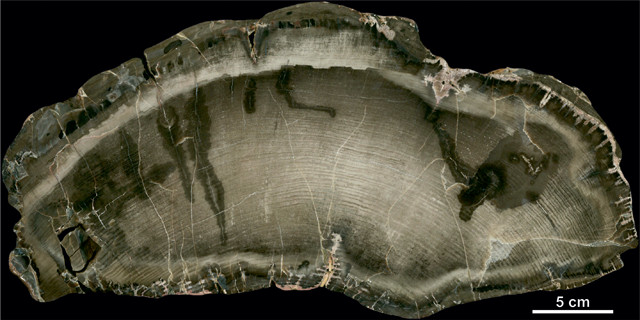
by Bethany Augliere Wednesday, April 19, 2017

A cross section of fossilized wood from the Permian-aged Chemnitz Petrified Forest showing 75 tree rings. Credit: L. Luthardt and R. Roessler.
The sun’s surface is home to dark, relatively cool blotches of high magnetic activity known as sunspots, which vary in number over a roughly 11-year cycle. In a new study in Geology, scientists found evidence of this solar cycle dating back 290 million years to the Permian Period.
During periods of more sunspots, more solar radiation, including light and heat, reaches Earth. “Whenever you get more [solar] radiation, the plants are happy and they grow well,” says Nat Gopalswamy, an astrophysicist at NASA’s Goddard Space Flight Center in Greenbelt, Md., who was not involved in the new research. A tree’s annual growth is recorded in its rings, which act like an archive and can provide clues to scientists about atmospheric conditions like temperature and moisture.
Ludwig Luthardt and Ronny Roessler, paleontologists from the Natural History Museum of Chemnitz, Germany, examined tree rings from a 290-million-year-old fossil forest, composed of conifers, tree ferns, seed ferns and horsetails, in what is now southeast Germany. The forest was instantaneously entombed by ash from nearby volcanic eruptions before the trees — many of them still in upright positions — could decay. “When a tree dies it still stores information, and we can read that now,” Luthardt says. Because these ancient trees grew at the same time and in the same locality, they should show the same environmental signals in their tree-ring sequences, he says.
After the forest perished, the original wood and its tree-ring structures were preserved by replacement of lignin and cellulose by silica and fluorite, so that trees are still three-dimensionally preserved. Out of thousands of samples, the scientists collected tree rings from the 43 best-preserved trunks and branches, which they analyzed under the microscope. By counting rings and measuring ring widths, they could determine how much the trees grew every year.
Luthardt and Roessler found evidence in 75 percent of the samples of a climatic signal with a regular periodicity of 10.6 years. This matches the range of the modern sunspot cycle, which is between 10.44 and 11.16 years. They documented six complete cycles in the period leading up to the volcanic eruptions that buried the forest. The findings suggest that the sunspot activity has been stable since at least the Permian Period, the researchers wrote.
“It’s a very interesting study,” Gopalswamy says. It gives a confirmation that the sun has been in a stable state for the most recent 10 percent of its history, he says.
“The fact that they [see] decadal-scale variability in the Permian is incredibly cool,” says Adam Csank, a paleoclimatologist from the University of Nevada, Reno, who was not involved in the study. But not everyone in the dendrochronology community is convinced this cyclicity is due to sunspot activity, Csank says. For one thing, “there are a very limited number of studies that have demonstrated a connection between sunspots and tree-ring widths,” he says.
Csank also notes that there are other possible explanations for the cyclicity seen in the petrified trees, such as oscillating climate patterns and insect outbreaks. For instance, the modern Pacific Decadal Oscillation and North Atlantic Oscillation operate at decadal cycles. And in the Alps, larch bud moths defoliate forests on an eight- to 10-year cycle. “I’m not saying it isn’t sunspots, but I’m also not convinced 100 percent that it is sunspots,” Csank says.
But, Luthardt says, there were no signs of insect activity in the samples they studied, and the best explanation for the cyclicity is a climatic signal related to sunspots. Solar scientists have hypothesized that increased radiation when there are more sunspots influences Earth’s climate today by affecting things like cloud formation, which, in turn, affects rainfall. The local paleoclimate of the Chemnitz Fossil Forest was subhumid, with monsoonal wet and dry seasons, so the major limiting factor in the environment would have been water, Luthardt says. He and Roessler proposed that the sunspot cycle’s impact on cloud formation could have also regulated annual precipitation and thus, plant growth, in the Permian.
© 2008-2021. All rights reserved. Any copying, redistribution or retransmission of any of the contents of this service without the expressed written permission of the American Geosciences Institute is expressly prohibited. Click here for all copyright requests.